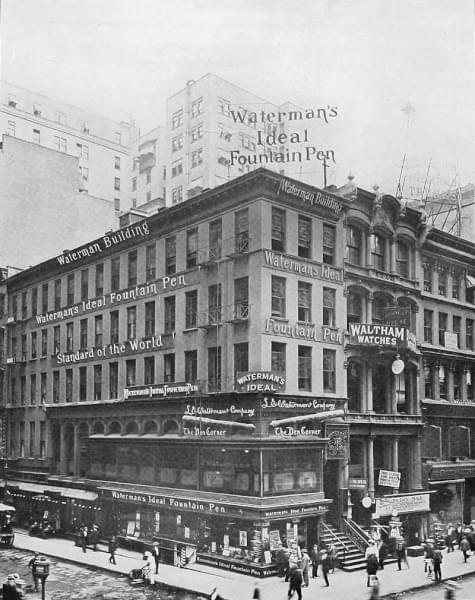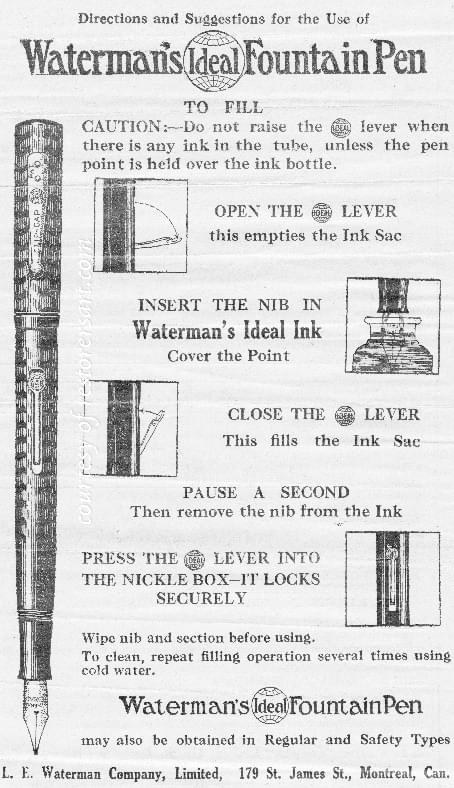
28 August, 2023
Waterman Pens: Innovation and Elegance At Its Best
Waterman pens are renowned for their exceptional craftsmanship, timeless design, and remarkable writing experience. With a history spanning over a century, Waterman has established itself as one of the most prestigious and influential brands in the world of fine writing instruments. Join us on a captivating journey through time as we delve into the rich history of Waterman pens, exploring their origins, revolutionary innovations, and enduring legacy.
Company Origins

The story of Waterman pens begins in the late 19th century when Lewis Edson Waterman, an enterprising American inventor, experienced a pivotal moment that would drive him to change the world of fountain pens. In 1883, Waterman encountered a frustrating incident during a crucial business deal. His fountain pen leaked ink, causing an embarrassing and potentially costly setback. Inspired by this incident, he embarked on a quest to create a fountain pen that would eliminate the issues of ink flow and leakage.
Driven by his determination to improve upon existing designs, he conducted extensive research and experimentation. In 1884, he filed a patent application for his groundbreaking invention, the "Three Fissure Feed" system. This patented mechanism introduced a novel approach to ink flow control, resolving the issues that plagued earlier fountain pen designs.
The "Three Fissure Feed" system employed a capillary action mechanism that revolutionized the way ink was delivered to the nib of the pen. His design featured three carefully placed channels or fissures within the pen's feed mechanism. These fissures allowed ink to flow consistently and evenly to the nib, ensuring a smooth and reliable writing experience. By using capillary action, the pen controlled the ink flow, preventing leaks and blobs while maintaining a steady and controlled supply of ink.
His invention marked a significant leap forward in fountain pen technology. Prior to his innovation, fountain pens suffered from inconsistent ink flow, resulting in blotchy and unreliable writing. His "Three Fissure Feed" system addressed these issues, providing writers with a dependable tool for elegant and consistent handwriting.
The success of this patented invention led to the founding of the Waterman Pen Company in 1884. The company quickly gained recognition in New York City for its high-quality pens. Waterman's commitment to craftsmanship and precision engineering attracted a loyal following of writers who sought a superior writing experience.
The introduction of Waterman's fountain pens coincided with a period of rapid industrialisation and increased demand for efficient writing tools. He capitalised on this opportunity and became a prominent player in the expanding market for fountain pens.
Early Innovations and Expansion

During the late 19th and early 20th centuries, Waterman pens played a pivotal role in changing the design and manufacturing of writing instruments. The brand introduced several innovative pen models that showcased their commitment to excellence, craftsmanship, and technological advancements. Let's explore some of the notable types of Waterman pens from this era:
- Waterman's Ideal Fountain Pen: This was a groundbreaking model introduced in the late 19th century. It featured the iconic "Three Fissure Feed" system, a revolutionary ink flow mechanism patented by Lewis Edson Waterman in 1884. This system resolved ink flow and leakage issues, ensuring a smooth and consistent writing experience. it quickly gained popularity for its reliability, elegance, and superior performance.
- Waterman Safety Pen: In 1904, they introduced the Safety Pen, a significant innovation in the world of fountain pens. The Safety Pen featured a retractable nib mechanism, allowing users to retract the nib inside the pen when not used. This mechanism prevented leaks, provided portability, and protected the nib from damage. It changed the convenience and practicality of fountain pens, establishing Waterman as a leading brand for reliable and user-friendly writing instruments.
- Waterman's Patrician Fountain Pen: Introduced in the early 20th century, it was a luxurious writing instrument known for its exquisite design and exceptional craftsmanship. The pen featured a unique celluloid body with marbled patterns and elegant gold or silver accents. The Patrician Fountain Pen showcased Waterman's dedication to blending artistry with engineering excellence, making it a coveted accessory for those seeking both style and functionality.
- Waterman's Ink-Vue Pen: In the 1940s this pen was introduced, which incorporated a transparent barrel that allowed users to monitor the ink level. This innovative design addressed the common issue of unexpectedly running out of ink during writing. The transparent barrel provided writers with a clear view of the remaining ink, ensuring uninterrupted writing sessions and preventing the frustration of emptying ink reserves.
- Waterman's Lady Patricia Pen: Launched in the early 20th century, it catered specifically to female writers. This pen featured a slimmer profile, delicate patterns, and refined colours, appealing to the preferences of women at the time. It exemplified their commitment to offering pens that combined elegance, functionality, and personalized designs.
Each of these pen models contributed to Waterman's reputation for excellence and innovation. By introducing features such as the "Three Fissure Feed" system, retractable nib mechanisms, transparent ink barrels, and pen designs tailored to specific audiences, they elevated the writing experience and set new standards in pen manufacturing.
Artistry and Elegance

Waterman pens have long been celebrated for their artistry and elegance, representing the perfect marriage of functionality and aesthetic beauty. Throughout its history, the brand has collaborated with renowned designers and artisans to create exceptional writing instruments that captivate the senses and embody the pinnacle of craftsmanship.
Waterman's pens from the early 20th century were exquisite works of art, featuring intricate engravings, delicate patterns, and lavish materials. The brand used precious metals, such as solid gold or sterling silver, to create pens that exuded opulence and sophistication. These materials not only enhanced the aesthetic appeal of the pens but also ensured their durability and longevity.
In addition to precious metals, they often incorporated exotic materials, further elevating their allure. Examples include:
- Hard Rubber: In the late 19th and early 20th centuries, they were often crafted from hard rubber, also known as vulcanized rubber. This material offered a sleek and smooth finish, providing an elegant base for engravings and embellishments.
- Mother-of-Pearl: They introduced pens adorned with mother-of-pearl inlays, creating a stunning display of iridescent colours and shimmering textures. Mother-of-pearl added a touch of natural beauty and uniqueness to the pens, making each piece a true work of art.
- Celluloid: They embraced celluloid, a versatile material, to create pens with vibrant and captivating designs. Celluloid pens often featured marbled patterns or translucent bodies, allowing the colours to come to life. The use of celluloid enabled them to achieve remarkable aesthetics and capture the imagination of pen enthusiasts.
Waterman's commitment to artistry extended beyond the materials used in their pens. The brand collaborated with renowned designers and artisans to create limited-edition and special collection pens that showcased exceptional creativity and craftsmanship. Some notable collaborations include:
- Lalique Collaboration: They collaborated with the legendary French glassmaker René Lalique in the early 20th century. Lalique's expertise in glasswork and intricate designs added a new dimension of artistry to their pens. The collaboration resulted in pens adorned with Lalique's signature motifs, such as delicately carved floral patterns or frosted glass accents, further enhancing the pens' elegance and beauty.
- Pierre Cardin Collection: They partnered with fashion designer Pierre Cardin to create a series of pens that combined sleek, modern designs with timeless elegance. The Pierre Cardin collection featured pens with streamlined profiles, geometric patterns, and innovative materials, reflecting the fusion of fashion and art in a writing instrument.
- Edson Collection: This collection paid tribute to the brand's founder, Lewis Edson Waterman, and his pioneering spirit. These limited-edition pens celebrated his heritage with exceptional craftsmanship, precious materials, and intricate detailing. It exemplified Waterman's dedication to creating pens that were functional and true objets d'art.
Waterman pens transcended their utilitarian purpose by collaborating with visionary designers and incorporating exotic materials, becoming highly coveted collector's items and symbols of sophistication. These artistic collaborations and the use of luxurious materials elevated them to the realm of fine art, captivating the hearts of pen enthusiasts and connoisseurs worldwide.
Philanthropy and Social Responsibility

Waterman Pens has long been dedicated to philanthropy and social responsibility, recognising the importance of giving back to the community and positively impacting society. The brand has undertaken several initiatives supporting education, arts, and environmental conservation, showcasing their commitment to blending exceptional craftsmanship with a responsible approach to corporate citizenship.
Education:
They recognise the power of education and has taken steps to support educational initiatives. The brand has partnered with educational institutions and organisations to provide resources and opportunities for students. For instance, they have collaborated with schools to sponsor creative writing competitions, encouraging young writers to express their thoughts and ideas. These initiatives aim to foster a love for writing and nurture the next generation of storytellers and thought leaders.
Arts:
They acknowledge the importance of supporting artistic expression and cultural enrichment. The brand has sponsored various arts programs and initiatives to promote creativity and provide platforms for emerging artists. They have sponsored art exhibitions, artist residencies, and cultural events, encouraging the appreciation and development of artistic talents. By supporting the arts, they contribute to the vibrancy of local communities and helps create a nurturing environment for artistic expression.
Environmental Conservation:
They recognise the significance of environmental conservation and sustainability. The brand has undertaken initiatives to reduce its environmental impact and raise awareness about environmental issues. They have collaborated with environmental organisations and participated in initiatives dedicated to preserving natural habitats, protecting endangered species, and promoting sustainable practices. By supporting environmental conservation, Waterman strives to ensure a better future for generations to come.
Social Causes:
They have also been involved in philanthropic efforts to address social causes and support communities in need. The brand has sponsored charitable events and partnered with organisations working in areas such as healthcare, community development, and humanitarian aid. These initiatives reflect their commitment to positively impacting society and improving the lives of individuals and communities.
They demonstrate a holistic approach to corporate citizenship by integrating philanthropy and social responsibility into their ethos. Their commitment to education, the arts, environmental conservation, and social causes reflects a deep understanding of the brand's responsibility to contribute positively to society. Through their philanthropic endeavours, they have enhanced their brand reputation and inspired others to make a difference and promote positive change.
The history of Waterman pens is a testament to the brand's unwavering pursuit of innovation, artistry, and excellence. From Lewis Edson Waterman's pioneering fountain pen designs to the brand's continued commitment to craftsmanship and elegance, it has consistently set new standards in the world of fine writing instruments.
Through a combination of technical advancements, exquisite design, and a commitment to quality, is has earned its place as a symbol of elegance, sophistication, and timeless style. As it continues to evolve and adapt to the demands of the modern world, its legacy remains rooted in a rich heritage of innovation and a passion for the art of writing.
The Printed Pens Team

